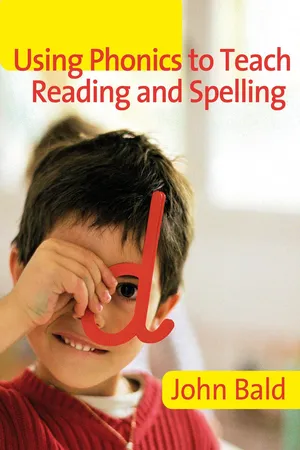
- 176 pages
- English
- ePUB (mobile friendly)
- Available on iOS & Android
Using Phonics to Teach Reading & Spelling
About This Book
Includes CD-Rom
Times Educational Supplement Star Read!
?This is an authoritative yet lively and eminently readable book. It is well grounded in both the latest academic theory and experienced hands-on pedagogic practice, and it summarises succinctly the implications of the recent Rose Report, giving a masterly exposition of both synthetic and analytic phonics and their places in the processes of learning to read and spell.
Practical and organisational issues are tackled in a most supportive way, with very useful checklists and photocopiable proformas on an accompanying CD.
The book also provides and excellent guide to provision for professional development, involving the use of lesson observation and part of the evaluation and planning cycle for CPD. Its style is clear and well signposted with subheadings, case-study boxes to illuminate points, and with aims given at the start of each chapter as well as challenging points for reflection and guides to further reading at the ends.
Every staff room should have one!? - Dorothy Latham, Primary Education Consultant, English specialist and author of How Children Learn to Write
?Synthetic phonics may well be only one tool for teaching reading and spelling, but it is the single most important one? - Ruth Kelly, Education Secretary, March 2006
?Teachers - and particularly Literacy Co-ordinators or SENCOs - who are enthusiastic about children?s learning and about their own professional development will undoubtedly benefit from using this book and CD, with its combination of useful explanation and practical resources to support the implementation of the ideas? - Lorna Gardiner, General Adviser, Foundation Stage, North Eastern Education and Library Board, Northern Ireland
Are you looking for practical advice on how to teach phonics?
By giving the reader a basic introduction to teaching reading and spelling using phonics, this book will provide you with easy-to-use ideas for your classrooms. Following on from the recommendations of the Rose Report, the author explains why teaching phonics works, and how to present irregular as well as straightforward features of English.
The book:
o contains practical examples and activities for teachers
o explains the basis of synthetic and analytic phonics
o gives advice on choosing the best resources
o looks at how to help the weakest readers
o includes a CD Rom with photocopiable resources and INSET materials
o contains a glossary of key terms
Literacy Co-ordinators, teachers and teaching assistants will find this an invaluable resource.
Frequently asked questions
Information
CHAPTER 1
Phonics, Why and How












Regular and irregular languages



Letter combinations
Table of contents
- Cover Page
- Title Page
- Copyright Page
- Contents
- Contents of The accompanying CD
- Acknowledgements
- How to use this book
- Foreword
- 1 Phonics, why and how
- 2 Key elements in synthetic phonics
- 3 Synthetic phonics and language development
- 4 How do we explain and tackle irregularity?
- 5 Phonics and English spelling
- 6 Phonics and more advanced literacy skills
- 7 Resources
- 8 What additional techniques can help the weakest readers?
- 9 Professional development
- Glossary
- Appendix: Key patterns in English spelling
- References
- Index